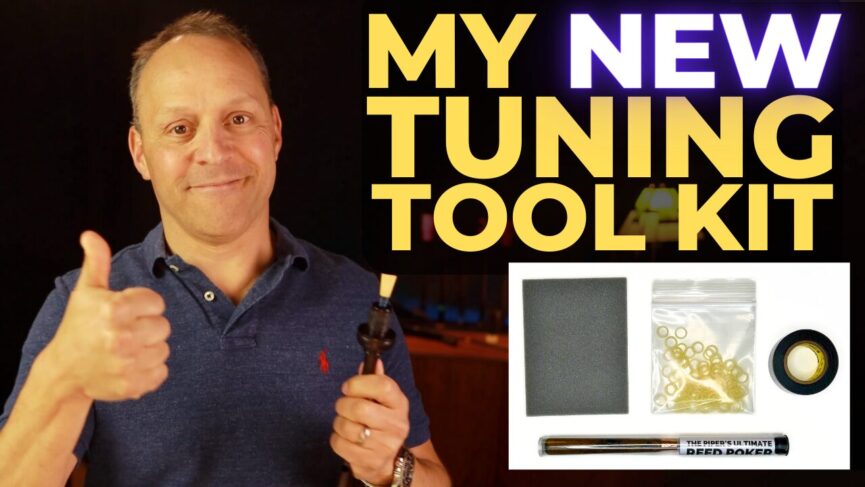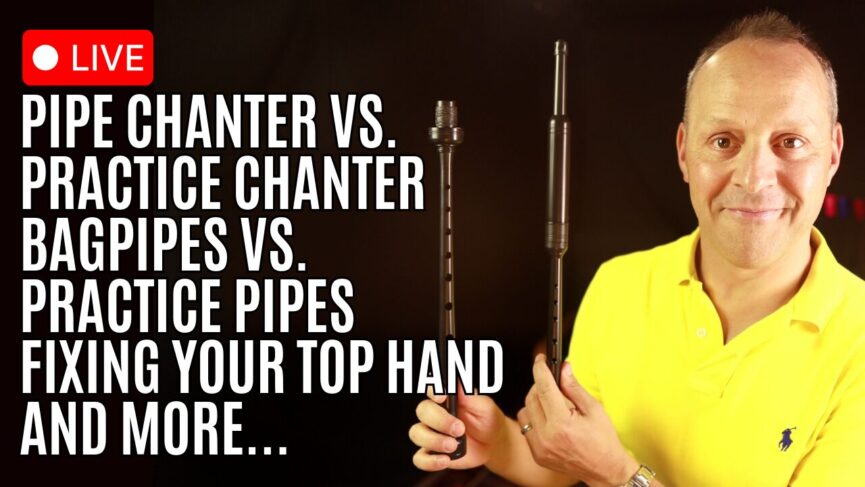
AS FEATURED IN

How to Read and Play the Repeats: Understand and Master the Repeats in Your Bagpipe Tunes
by Jori Chisholm, Founder of BagpipeLessons.com
Last Updated: February 14, 2024
I’m Jori Chisholm, the founder of BagpipeLessons.com In today’s video, we are going to talk all about one of the most important features of bagpipe music and this is: repeats. Bagpipe music is very rhythmic and also very structured. Most bagpipe tunes have musical phrases and parts that are played more than once, sometimes several times. But the repeating patterns can change and the way that bagpipe sheet music is written is not always that clean which can make it really hard to follow and understand exactly what you are supposed to play.
You are going to learn everything about how to correctly read, understand, and play all of the different types of repeats in bagpipe tunes. We’ll look at several examples of tunes, and the different ways that tunes repeats and the different ways the music can be written. You will gain a complete understanding of repeats in bagpipe tunes so you will be able to read and play your tunes with confidence.
Watch the video and scroll down to read the full video script.
Video Transcript:
Today we’re going to talk all about one of the most important features of bagpipe music, and that is Repeats. Bagpipe music is very rhythmic and also very structured. Most bagpipe tunes have musical phrases and parts that are played more than once, sometimes several times.
But the repeating patterns can change and the way that bagpipe sheet music is written is not always that clear, which can make it really hard to follow and understand exactly what you’re supposed to play.
In today’s video you’re going to learn everything about how to correctly read, understand, and play all of the different types of repeats in bagpipe tunes. We’ll look at several examples of tunes and the different ways that tunes repeat and the different ways that the music can be written.
By the end of this video you’ll have a complete understanding of repeats in bagpipe tunes, so you’ll be able to read and play your tunes with confidence. Stick around, you’re going to love this video.
Welcome to BagpipeLessons.com where you’ll find the inspiration and knowledge to fulfill your piping dreams. Today I want to take a few minutes to talk about the repeat symbol. So we see a lot of these in pipe music at the end of a part and these two little dots there means to go back and repeat that part.
If you look at all of our pipe tunes, all the pipe tunes that have ever been written, 99% of them are more probably fit into a basic pattern which is two parts or four parts, sometimes you get six, but it’s usually two or four parts and you repeat the parts and each part is going to be eight bars.
Again, not all tunes but almost all of them. So if you take a look here, most pipers know, “Green Hills,” this is a three four and if you look we have, this is a very common pattern that we see almost all the time which is one, two, three, four, one, two, three, four.
We have eight bars in the first part, eight bars in the second part and the parts are repeated. So we know that because at the end of this eighth bar there is our little repeat symbol, our two dots and that means we go back here to the beginning.
Often you’ll see the two dots at the beginning which shows you the start of that part. So you’re going to play these two lines, play them again and then the second part, same thing, play these two lines, play them again and that’s the whole tune.
So, just to review what I said at the very beginning here, almost all of our tunes fit this pattern which is eight bars per part, some number of two or four or sometimes six parts. Occasionally we get three -part tunes but it’s pretty rare.
Now there’s a couple exceptions to the rule about repeating parts and that is strathspeys and reels and four four marches. For some reason, those three, strathspeys, reels and four fours, we don’t repeat.
So on those tunes we’ll have the same thing, eight bars per part but straight through, no repeats. So here’s another tune, the “Brown-Haired Maiden,” common two four marches that a lot of us know. So here’s our first part, again we have repeat marks.
So we’re going to play line one, line two, line one, line two then we go on to the second part. If you look at the second part, no repeats here. So what this is is you would play straight through, you just play straight through one, two, three, four lines and then you’re done.
Well, why is that? Why did they write out all four lines in full instead of the same two lines played twice? Well, it’s because there’s a difference here and actually the way the tune is written is that if you look at something a little bit different here in this last line.
But that’s really it, is that this line here is slightly different. So if we number our lines one, two, three, four, five, six, when you actually play the tune you’re going to play line one and then line two and then line one and then line two because of the repeat and then we’re going to play three, four, five, six.
Now as you know this tune, if you played it before, if you just kind of study it, what you’ll see is that line three and line five are the same. So if we instead of labeling that five, label that three.
Now we have one, two, one, two, three, four, three, six. So sometimes you’ll see a tune like this written out in full, but they can also do what they call a second ending, which is what we have here.
So instead of writing out, so again, if we number them one, two, three, four, five, part one is going to be one, two, one, two. Part two is going to be three, four, three, five. Let’s go back and look at that.
So we play our first part, play it again. Then we do our second part. We start here. Now we go to here. What is this number one with this bracket? This means first time. So the first time we play this part, go here and then play the first time.
Then we go back to the beginning and we play this again, but we can’t play first time because this means you only get to play it the first time only. So then we’re going to jump down here, which is the number two, which means the second time.
So first time is line three, four, second time is line three and five, which is the exact same thing that we had on this other one. This is no longer line six, it’s line five. So three, four, three, five, three, four, three, five.
All we’ve done is in this version, they’ve saved a little bit of space by not writing out our line three twice. That makes sense. So very common in piping, what we have is repeats, but then there’ll be what they call a second ending.
And that happens all over the place in five tunes. Let’s move on. Here we have an amazing jig, one of the best, Biddy from Sligo. Great tune. Now let’s take a look here. Here’s our first part. Repeat right there, so we’re going to play our first part and then repeat it.
Here’s our second part. Play these two lines and then repeat it. Now if we look at our third part, no repeats anywhere. So our whole third part is here and then our whole fourth part is here. So it doesn’t mean that it’s twice as long.
In fact, the third and fourth part are exactly the same length as the first two. It’s just instead of up here where we have the same two lines played again here, something different. Now again, if you look at it here, you can see there’s only a tiny difference here in this third part and that’s right here.
That’s the only difference between them. We wrote out this third part in full just for that one reason. You think, well, why did they do that? Isn’t there a way that we could save repeating this entire line, repeating all this stuff here?
Because of that one bar being different? Sure. And that’s what we have here, which is we’ve written our first ending and our second ending here. So I guess it’s not even really a first ending because it’s not at the end of the part.
So here’s our first part, here’s our second part, here’s our third part. And if you look at it closely, there’s a little tiny one and a bracket that encloses this section here. And there’s a little tiny two and a bracket that encloses this section.
So the first time you play the third part, you’re going to play along here, come down, play the number one, skip the number two and then finish it. Then when you repeat, you play the first line and then you skip the number one and you only play the number two and then you finish it.
And then our fourth part will always be written out in full because it’s a very cool part, but it’s actually four completely different lines. So there’s no shortcutting it. We just have to write it out in full.
But this is actually quite rare to have two brand new lines to finish up the part. Usually it’s just the ending like we had in Brown-Haired Maiden or it’s a little section here. The video you’re watching was created for members of my BagpipeLessons.com Inner Circle.
With your membership in the Inner Circle, you get full access to the very best of everything at BagpipeLessons.com. This includes weekly live interactive online classes for pipers of all skill levels, led by me and world champion guest instructors.
You also get access to my exclusive lesson library filled with hundreds of videos, lessons, tunes, exercises, demonstrations, and more, covering every topic in piping from music theory to technique to tuning, maintenance, setup, and so much more.
And you get personalized support from me to help you reach your piping goals. To find out more about joining my Inner Circle, please visit BagpipeLessons.com/membership. Another thing to watch out for is just some of these older settings.
So if you’re used to reading pipe music that’s been typed in on computer, they do a really nice job of four lines, or sorry, four bars in a line, two lines to a part. So every part always ends on the right margin of the page.
It wasn’t always like that. In fact, some of these older books, if you look at it, this is the same tune. You know, before computers, it was expensive to have something professionally type set. And also every piece of paper in the book was expensive.
So they tried to just cram things in as much as possible. So here is your first part, and actually your first part ends right there. So first part here, and then our second part starts here, kind of carries on, it sort of finishes there.
Third part’s here. There’s our little variation in that third part. And then finally our fourth part starts here. So the exact same number of bars per part, eight bars per part played exactly the same way, but it’s just a little bit confusing because it jumps around the page.
I really like the type setting in some of these old books. I think this might be one of Donald McLeod’s books. I sort of like the font, and I like the boldness of the notes compared to, you know, some of the computer printing that we have today.
But I do find it visually a little bit hard to decode. I think in terms of learning the tune, it makes it easier when you have visually the tune lining up four bars per line, and then your two lines give you your eight bars per part.
So sometimes I’ll actually take this and rewrite it, or I haven’t done this recently, but I used to actually take a photocopy and cut it up with scissors and tape and have it line up. Might seem a little bit obsessive, but I think just visually seeing it can sometimes help.
So you’re not trying to find “where’s the third part start?” You know, that you just know it always starts on the left side. So that’s the jig. So going back to what we talked about before in terms of our sort of standard second ending, this is a two, four march called Greenwoodside.
First part is just regular with repeats. You can play the line one, line two, line one, line two, and then we have our second ending down here in the second part. But the reason I wanted to show you this is that the first ending actually starts right in the middle of this bar here.
Well, why is that? Well, let’s take a look. It’s because from right there, it’s sort of the one, two, three, it’s sort of in the middle of the second beat of that bar. And what it is is that this D throw sort of fits in naturally with what comes next.
If you look at the pickup notes here, there’s sort of a D throw E and then it’s an F is the first note of that full bar. Well, the same thing here. We’re starting with the same F. So we want to have sort of the same pickup notes.
So it actually makes sense. It’s just repeating that phrase there. However, on the second ending, the second ending really goes back up to the first part. If you look at this BBB GDE thing. So because it’s the same thing down here, we actually want the pickup note to be the same.
And that’s how the tune is written. So the pickup note is the F. So they start that ending here right there. So you’ve got this last half of a beat is the first ending. And then on the second ending, you’ve got your F pickup note.
So it all makes sense. It’s just going back to that first part. The ending has to include the pickup notes. Now what’s interesting is that because this last line, the second ending really goes back to the first part, they could have saved more space by crossing that whole thing out and just putting a second ending here and saying, two of two, which would mean second time of the second part.
Again, we’re just saving a little bit more ink, a little bit more space. I prefer that. I always prefer to have music that’s written out with as little repetition as possible, just so it helps you understand, oh, well, this is not a new line.
Just because there’s three lines written out, you might think, oh, I’ve got to learn a new line now. No, it goes right back there. I think if they would have written it that way, it makes it a little bit clearer.
This idea of having your first part sort of played regular with repeat, second part having a second ending where it goes back apart. You actually will see that a lot in pipe tunes. And that’s why I want to show you this tune here, which is the Clan Macrae Society.
And what’s really interesting about it is if you look at these second endings, it has exactly what I just talked about. This is two of two. So that means you’re going to play this line the second time through the second part. It doesn’t affect the first part. So line one, line two. Let’s just number all these. Thank you. of 12 lines. So the first part, we’ve got our repeats, it’s going to be 1, 2, 1, 2. Second part is going to be 3, 4, but then it’s going to be 3 and then we jump back up here to 2.
So the second time to the second part, we go back to the first part. Again, third part, same thing. It’s just going to be 5, 6, 5, 6. Again, this is 2, 4, which means it doesn’t affect the third part.
It’s on the fourth part where we go 7, 8, 7, and then we pop back up 7, 6. So again, just like from the second part, in the second time we went back apart to the first, same thing here. On the fourth part, second time we go back to the third part.
Again, then our pattern carries on. Our fifth part, 9, 10, 9, 10. Sixth part, 11, 12, 11, 10. So it drops back apart. So pretty cool. It sort of helps the whole tune hold together, especially when you get these tunes with lots and lots of parts.
There’s a lot of variation, so it’s nice to come back and hear something that you’ve just played previously. One last thing I want to talk about repeats, and that goes back to what I talked about earlier, which is with our, the types of tunes that get repeats.
And I mentioned before that we repeat the parts in all of our tunes except, except our strathspeys. So let’s, let’s back up. Except strathspeys and reels and 4 4s were the ones that we don’t repeat the parts.
So here we have John Roy Stewart, a great traditional strathspey. Here’s our first part here. Again, no repeats because we don’t repeat parts in strathspeys. So if I say there’s no repeats in strathspeys, well what are these repeat marks doing here?
Well, it’s because it’s the same four bars played twice. And then our fourth part. So remember all of our tunes have eight bars per part. There’s four and four makes eight, four and four makes eight, four and four makes eight here in the third part.
So it’s just the same four played twice. And sometimes you’ll see that written out in full. Sometimes you’ll see it written with a repeat mark here. It doesn’t mean that it’s half as long. It doesn’t mean that this part is “repeated.”
None of the parts repeated just happens to be that this part is made up of the same four bars. Hope that makes sense. It’s not too confusing. And the last one I wanted to show you is another great strathspey by Donald MacPherson.
Here’s our first part. Again, it has the repeat marks because it’s the same four played twice. There’s our eight bars. There’s our same four bars played twice for eight. There’s the same four played twice for eight.
So again, just two. So no repeats for strathspeys and reels and four fours and then everything else repeats. And that would be two fours, three fours, six eighths, nine eighths, jigs, horn pipes. Forgetting anything else?
Pretty much everything else. I don’t know the historical reason for this over here, but I suspect the strathspey, the reel, has to do with the dance. So if you ever do piping for dancers, you will need to figure out the number of parts that you’re going to be playing in a tune for for the dancers, and they have their dances in steps.
So they’ll do what they call a four -step fling or a six -step highland fling or a four -parted Seann Triubhas or a four -parted hornpipe or whatever. And what we call parts they call steps. So you need to figure it out and I suspect it has to do with the number of steps lining up with the number of parts of the tune.
Because if you’re going to play a strathspey for a highland fling, you do four parts of strathspey equals four steps of highland fling. Whereas over here in the jig, if you’re going to play for a highland dancer and it’s four steps of jig, it’s going to be four parts of jig with the repeats.
So it’s sort of like how we play the tunes matches up with the highland dance. These things sort of evolved with each other, you know, over time. I don’t know about four four marches, but it might just be that four fours are already so long.
They have twice as many beats as a two four. So if you repeated them, they might just sound really, really long. So I don’t know the answer to that, but it’s an interesting question. There you go. I hope that helps your understanding of your repeats, when we repeat, maybe a little bit about why we repeat things, and also decoding our first and second endings in your sheet music.
Good luck. If you have any questions or comments, please leave them below, or maybe you have a specific question about a particular tune. Let me know. I’m happy to help. For more videos, lessons, and free guides, be sure to visit BagpipeLessons.com/Learn and download my free guide called Learn the Pipes Right.
The link is in the description below. I’d love to be part of your piping journey. For more information on joining my BagpipeLesson.com Inner Circle, please visit BagpipeLessons.com/membership.
And don’t forget to hit the subscribe button and click the little bell to be notified when I post new things here on the BagpipeLessons.com YouTube channel. Thank you and happy piping.





